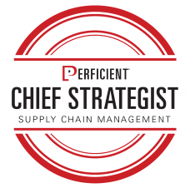Thrilling our clients with innovation and impact – it’s not just rhetoric. This belief is instrumental for our clients’ success. In 2018, we announced the first class of Chief Strategists, who provide vision and leadership to help our clients remain competitive. Get to know each of our strategists as they share their unique insights on their areas of expertise.

As consumers, we’re accustomed to the convenience of online shopping, free shipping, and receiving our items in two days. Delivering on this new expectation is possible with a streamlined supply chain.
Even beyond retail, supply chain management is paramount to success across industries and impacts businesses of every size.
Bob Vanek, Perficient’s Supply Chain Management Chief Strategist, leads our supply chain practice and has more than 20 years’ experience with implementing business transformation programs in supply chains. We recently spoke to Bob and learned more about his aspirations as a chief strategist, his perspective on supply chain management, and his life beyond the role of chief strategist.

What does this new role as a Chief Strategist mean to you?
Bob Vanek: It’s exciting because this role brings more visibility to Perficient for our supply chain solutions. Being introduced as a Chief Strategist carries more weight and provides clients with an immediate understanding of my specific focus area.
Whether it’s after an in-person meeting or a call, clients follow up with specific questions around supply chain because they understand how we’re contributing to the discussion around their business problem. It positions us well to lead with a business solution and follow along with more significant technology implementations.
What does your role as a Chief Strategist entail?
BV: My role provides perspective for clients looking to optimize their supply chain. I can contribute my expertise to discussions led by our business development teams. My specific areas of expertise include inventory tracking and visibility, reverse logistics, and purchase-to-pay.
Additionally, our management consulting practice has deep supply chain knowledge that includes transportation, warehouse management, strategic sourcing, and more. Supply chain management impacts a large portion of our clients’ [operations] and presents a new opportunity for advancement in those areas.
What do you hope to accomplish?
BV: Elevating the awareness of our supply chain management expertise is among my top goals. We have supply chain [projects] happening in a few significant accounts. We’ve also worked with Perficient Digital’s commerce group around supply chain for a large furniture retailer. There are a number of scenarios where, once we get in and have a good relationship with a client, the word spreads and gives my team more opportunity and visibility.
In the long term, I would love for my team to reach a point where we’re frequently having conversations with our largest clients about supply chain.
Strategically Speaking
What do you see happening in supply chain management in the next few years?
BV: Many in the supply chain world call it the “Amazon effect.” Everyone recognizes how Amazon has affected consumer business (and customers’) expectations in a huge way. Now the question is: How does the “Amazon effect” impact other companies with respect to the business-to-business (B2B) side of supply chain expectations?
This touches on things like the expectation of full product lifecycle visibility. Blockchain and the Internet of Things (IoT) are tied into that. The technology working behind the scenes is less critical than the ability to have visibility to that entire inventory, where it is, and what is needed.
The major driver for supply chain’s future is customer expectations – the kinds of information they can get from their supply chain is somewhat never ending. In five years, it wouldn’t surprise me that when I take my laptop to Best Buy to be recycled, I will know exactly what happened to it on the back end and have the peace of mind that it’s not in some landfill somewhere.
In supply chain, if you start looking at the volume of byproducts (e.g. containers, clam shells, packaging materials), it’s pretty astounding. For example, we just went through the holiday season. Think about how much material each home either recycled or trashed. That costs suppliers money to get the materials to the consumers but has no real value. The resulting waste is not valuable to anyone. How is the industry going to address these changes? What does that look like, and how will companies deal with this in the future? These kinds of questions will continue to have a large impact on what companies need to do from a supply chain perspective.
What excites (or concerns) you about what’s happening in supply chain management?
BV: The expectations concern me the most, whether it’s regulations from the government or public opinion. These things can change quickly, and the impact they have on the massive volumes of products that move from the smallest providers to leading enterprises. Some of this change, and how it affects supply chain, is exciting. The scary part is, how do you get it done?
Businesses continue to wrench down on efficiencies within supply chain, but it’s technology and innovation that will help companies win in the future. Businesses that align their efficiency with customer expectations, both in quality and impact to society, will have the greatest advantage.
There are expectations on the impacts of the supply chain we’re creating. Consider future trends like autonomous trucks driving across Interstate 70 in Kansas. What does that really mean? How does that change the world and change how products get into cities? How do we make new technologies as effective and efficient for all the people impacted by it?
Why does strategy matter for your business?
BV: Strategy is vision and planning. Much of our work involves creating roadmaps and strategic discussions around what the business will look like in the future. We talk about where our clients’ business will be one, three, and five years down the road.
As an example, we’re currently working with communications providers that realize customers have changed. Connected devices and streaming services have changed how they want content delivered.
If your company isn’t looking to the future and strategically figuring out how to get there, you’re dying. Strategy is as fundamental to any business as production, delivery, and customer care. It’s a fundamental component of business. If you don’t believe me, just ask Blockbuster.
Think like a Chief Strategist
How does your team help clients on their digital transformation journey?
BV: Digital transformation helps to improve efficiencies and processes within supply chain. If you drill down and get to the IoT side of things, that’s even more interesting. IoT gets to more of the real-time visibility that’s happening within your supply chain.
From a blockchain perspective, the need to have visibility on where everything is – from the time it’s created through the time it’s consumed, and even all the way through to how it’s disposed – becomes increasingly important.
More companies are leaning towards being greener, from providing visibility on food sources to disposing of electronics in an environmentally responsible way. Society – and to some extent legislation – will force these requirements onto companies. Other companies will take this on because of their own views on social responsibility. These changes open up a need in supply chain around digitally tracking and providing this level of visibility.
What questions do you ask a client when creating a supply chain strategy?
BV: The first question is, “What has to change for you to be successful within your industry?” You can tailor this to supply chain, or any business problem, but that’s how we start conversations with our clients.
We follow with, “What are the limiting factors within your supply chain capabilities that will prevent you from achieving your vision? Where do you want to be? What needs to be in place, or what will hold you back from achieving that future goal?” And finally, “What are the threats to continue operating your business the way that you are today?”
Consider the grocery industry as an example. If you were to ask, “What does home delivery look like, and how does that change the way you need to operate in two years? How does food tracking to improve food safety change the way you need to operate in the future?”
These are the questions that initiate conversation around business cases and strategic direction. This subsequently leads to projects, process changes, and technology solutions to support it all.
Beyond the World of Strategy
Tell us about yourself, and your interests when you’re not wearing the Chief Strategist hat.
BV: With my wife and three kids, I stay busy with them and their activities. I have a 15-year old son and then two daughters, ages nine and seven. I do a lot of youth coaching for their softball and basketball teams.
My family background is in baseball. In fact, my grandfather lived his life working for the St. Louis Cardinals and signed Stan Musial. With that lifelong baseball history in my blood, I still play softball at least once a week.
Learn more about each of our Chief Strategists by following this series.
